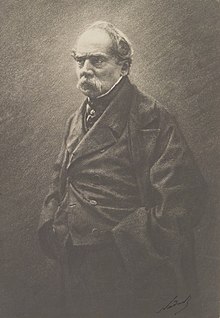Constantin Guys

Ernest Adolphe Hyacinthe Constantin Guys (born December 3, 1802 in Vlissingen , Netherlands , † March 13, 1892 in Paris ) was a Dutch-French painter and draftsman .
life and work
As the son of a commissioner for the Navy, Constantin Guys only began a military career. He left home at the age of eighteen and took part in the Greek War of Liberation . In 1827 he joined a dragoon regiment . He then worked as a correspondent and war draftsman in the Crimean War and worked as a watercolor painter and illustrator for British ( The Illustrated London News ) and French newspapers. As an artist, Guys was a self-taught artist . He trained his skills by studying the work of Jacques Callot , Rembrandt and Francisco de Goya .
It was not until 1830 that his artistic breakthrough came with drawings and lithographs . He traveled to the Orient , he visited London and Paris, where he finally settled in 1860. Constantin Guys was friends with Charles Baudelaire , Honoré Daumier and Félix Nadar . Charles Baudelaire described Guys as a painter of modernity .
The subjects of his painting were devoted to life in the Second French Empire . He went down in history as an artistic and witty chronicler of the life of his time . The basic theme of his pictures was bourgeois society, its vanities and military activities in the wars of his time. According to Baudelaire, the Illustrated London News commissioned war reports in graphic form . The Parisian social life with its amusements and vices Guys closely observed and also reflected the social differences.
In 1885, Guys had an accident in which he lost both legs. He spent the last years of his life in a Paris hospital.
effect
In 1964, works by Guys were shown in the hand drawings department at documenta III in Kassel .
literature
- documenta III. International exhibition ; Catalog: Volume 1: Painting and Sculpture; Volume 2: Hand Drawings; Volume 3: Industrial Design, Graphics; Kassel / Cologne 1964
- Zeitler, Rudolf: The art of the 19th century -. Propylaea art history ; Frankfurt 1990 ISBN 3-549-05111-5
- Literature by and about Constantin Guys in the catalog of the German National Library
Web links
Individual evidence
- ↑ "Often bizarre, violent, exaggerated, but always poetic, he knew how to press the bitterness or the intoxicating sweetness of the wine of life into one of his drawings and to give them durability." French original: “ Le peintre de la vie modern ”, accepted for publication by Figaro in 1863 . Quoted from: Charles Baudelaire: The painter of modern life , in: Essays on literature and art 1857-1860 . Volume 5 of the edition in 8 volumes. Zweiausendeins (license Hanser), 1989, pp. 213-258, quotation p. 258 (the last sentence of the article).
| personal data | |
|---|---|
| SURNAME | Guys, Constantin |
| ALTERNATIVE NAMES | Guys, Ernest Adolphe Hyacinthe Constantin (full name) |
| BRIEF DESCRIPTION | Dutch-French painter and draftsman |
| DATE OF BIRTH | December 3, 1802 |
| PLACE OF BIRTH | Vlissingen , Netherlands |
| DATE OF DEATH | March 13, 1892 |
| Place of death | Paris |
